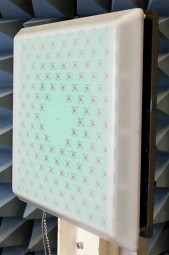Agile Aperture Antenna Technology is developed by Georgia Tech Research Institute. It is expected to have more reliable and faster data tranmission about video,audio and environment.This is the technology the signal can be transferred easily without distortion in water and environmental conditions such as temperature, oxygen, salt etc..
In December 2012, the antenna was attached to a Wave Glider vehicle and placed into the ocean off the coast of Hawaii. The Wave Glider, an autonomous marine robot developed by California-based Liquid Robotics, Inc., uses only the ocean’s endless supply of wave energy for propulsion. The Wave Glider can collect ocean data for a wide range of applications, including meteorology, oceanography, national security and offshore energy. Solar panels on the vehicle power the antenna, which requires only 0.25 watts of power and can switch up to 1,000 beams per second.
During the demonstration, the antenna maintained a satellite link with a sustained data upload rate of 200 kilobits per second (Kbps) for several hours, despite the Wave Glider rolling and yawing back and forth on the waves. The Agile Aperture Antenna required significantly less power and space to achieve these test results than a gimbaled antenna or a phased array solution.
“Because the antenna autonomously tracked its own position and orientation relative to the satellite and steered itself to stay connected, it maintained a highly directional antenna beam to the satellite as the craft moved around, which enabled data transfers near the maximum expected rate of 240 Kbps,” said Gregory Kiesel, a GTRI senior research engineer. “Antenna integration was also easy because the craft did not need to communicate with the antenna to maintain the connection.”
The Agile Aperture Antenna requires less power and takes up less space than traditional antenna solutions including mechanical systems and phased-array antennas. The technology also exhibits higher reliability than mechanical systems and is less expensive than phased-array antennas.
“The combination of the Wave Glider’s long duration and intelligent autonomy capabilities through GTRI’s new Agile Aperture Antenna provides customers with increased communications precision through the roughest of seas,” said Richard “Scoop” Jackson, director of federal business development with Liquid Robotics. “The availability of the GTRI Agile Aperture Antenna on the Wave Glider SV Series comes at a perfect time when deployment of autonomous surface vehicles for maritime security is rapidly increasing due to the cost and capability advantages.”
The antenna’s performance can be optimized because it is reconfigurable, which means the electrical structure of the antenna can be easily changed – even while in operation in the field. The antenna consists of a thin dielectric substrate that supports an array of square, metallic patches that can be switched on or off as needed to provide the proper configuration. The researchers measure the antenna patterns to determine which switches should be open and which should be closed to optimize the antenna performance.
Source: Georgia Tech News

